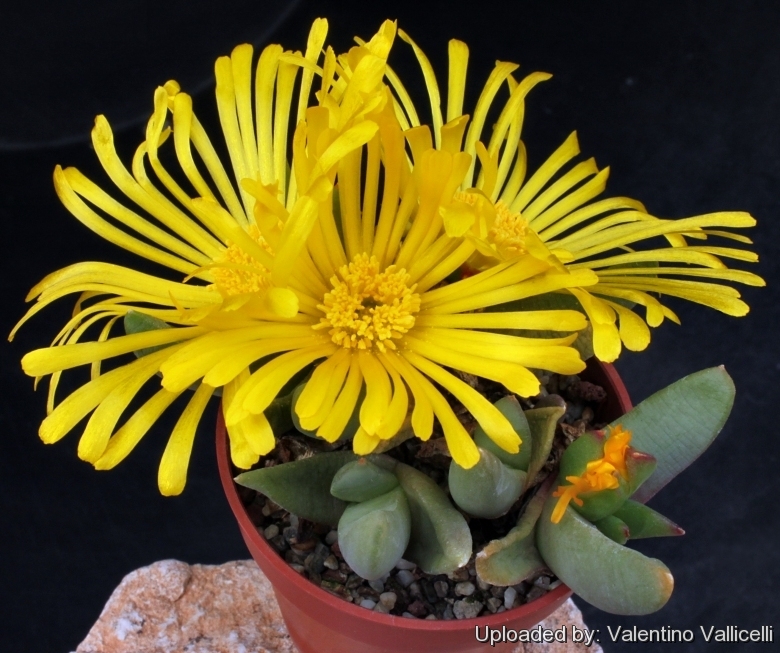Accepted Scientific Name: Glottiphyllum suave
Gard. Chron. 1928, Ser. III. lxxxiii. 13.

Glottiphyllum aff. suave SL-84-357 16 km south-west of Laingsburg Photo by: Valentino Vallicelli
Has super scented flowers.
Origin and Habitat: 16 km south-west of Laingsburg.
Synonyms:
See all synonyms of Glottiphyllum suave
back
Accepted name in llifle Database:Glottiphyllum suave N.E.Br.Gard. Chron. 1928, Ser. III. lxxxiii. 13.Synonymy: 3
back
Description: Glottiphyllum aff. suave SL-84-357 16 km south-west of LaingsburgSN|1091]]SN|19106]] is nice local or morphological form of the variable Glottiphyllum suaveSN|19106]]SN|1091]] characterized by very scented flowers.
Habit: It is a small, compact, very succulent, prostrate, clump-forming plant that forms whorls of waxy green leaves up to 10 cm in diameter (but often more in cultivation).
Stem: Almost stem less.
Leaves: Not clearly in 2 to 4 ranks, 3-5 cm long, 1,5-2 cm wide, equal or moderately unequally tongue-shaped, tapered to to a sharp point, one leaf of the pair obliquely keeled on the lower surface, soft, glossy, light absorbing, and dark-green to waxy grey without visible dots. They are succulent and very juicy in texture, reminiscent of gummy bears, in full sun they assume a purplish colouring
Flowers: Stalk-less, daisy-like, pale to bright yellow, glossy, large (4-8 cm in diameter), fragrant and very showy. They are clustered near the centre of the rosette. They are self-sterile, which means that you need different plants from the same location to obtain seeds.
Blooming season: The conspicuous flowers come mostly in lat Autumn through to late in winter.
Subspecies, varieties, forms and cultivars of plants belonging to the Glottiphyllum suave group
Notes: Glottiphyllum suaveSN|1091]]SN|1091]] differently to other mesembs that expand their flowers only in bright sunshine, will expand its flowers in a very dim light too. These very large golden yellow flowers open in all weathers and have a perfume resembling mimosa.
Bibliography: Major references and further lectures
1) Ernst Van Jaarsveld, Ben-Erik Van Wyk, Gideon Smith Succulents of South Africa: A Guide to the Regional Diversity Tafelberg Publishers, Limited, 01/lug/2000
2) Gustav Schwantes The Cultivation of the Mesembrythemaceae Blandford Press, 1954
3) Heidrun E. K. Hartmann Illustrated Handbook of Succulent Plants: Aizoaceae F-Z Springer, 2002
4) James Cullen, Sabina G. Knees, H. Suzanne Cubey The European Garden Flora Flowering Plants: A Manual for the Identification of Plants Cultivated in Europe, Both Out-of-Doors and Under Glass Cambridge University Press, 11/ago/2011
5) Gardeners' Chronicle, Horticultural Trade Journal, Volume 83 Haymarket Publishing, 1928
Cultivation and Propagation: The plants in this genus represent some of the more easily cultivated succulent species. Their main growth period is in late winter and were heading for spring-summer dormancy, but they do best with at least a little water all year. Requires little water otherwise their epidermis breaks (resulting in unsightly scars). Water moderately from the middle of summer to the end of winter, and keep the compost almost dry when the plants are dormant. Water minimally in spring and summer, only when the plant starts shrivelling (, but they will generally grow even in summer if given water) In areas prone to frost, grow in an intermediate greenhouse or conservatory, in pots of cactus compost, obtainable from good garden centres. Keep cool and shaded in summer, but provide maximum light the rest of the year. Remember that a sunny locality is best, otherwise they will not flower properly. However there are two ways to grow glottiphyllums: The first is to let nature take her course, which means giving them large pots and copious water; they will burgeon into enormous masses of glistening green leaves. The other is to starve them into svelteness by hot summer droughts, small pots, and firm loam. The results can be very attractive. In any case it is best to treat them as late winter growers. Soft leaves mean easy to damage. May be susceptible to mealybugs.
Propagation: Seeds or cuttings. Seeds germinate very easily and can be sown in early to mid-spring, but can be sown at most times of the year (Avoid very hot weather in summer) and germinated in heated humid environment. Do not sow the seeds too deep. If sown too deep, they will be smothered and probably not germinate. Under ideal conditions, seedlings will grow rapidly. Plant the seedlings out when they are 3–5 cm in height.
Alternatively, use stem cuttings taken towards the end of summer in an heated propagating case (15-21°C) Cuttings root easily and remain true to the species, while seeds tend to hybridize.











